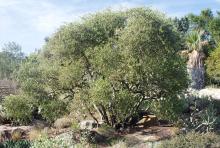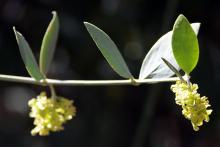Simmondsia chinensis
Common name:
Jojoba
Goatnut
Pronunciation:
sim-MONDS-ee-uh chin-EN-sis
Family:
Simmondsiaceae
Genus:
Type:
Broadleaf
Native to (or naturalized in) Oregon:
No
- Evergreen shrub, slow growing to 6-10 ft (1.8-3 m) tall, slightly less in width, much-branched, irregular shape. Leaves simple, opposite, 2.5-4 cm long, 0.6-2 cm wide, oblong-ovate, leathery, dull blue-green. Dioecious - male and female flowers on separate plants, occasionally on the same plant. Female flowers borne singly, 10-20 mm, 5 overlapping sepals, no petals, 3 styles; male flowers only 3-4 mm, in small clusters, greenish, 8-12 pale yellow stamens. Fruit about 2.5 mm, green but finally brown, nut-like, ovoid, tough, leathery, obtusely 3-angled, edible, tasting somewhat like hazelnut, but it is slightly bitter until cured.
- Sun to light shade. Needs well drained soil, limited summer water. Sometimes used a a sheared hedge or a foundation plant in desert gardens. If fruit is desired, include a male for pollination.
- Hardy to USDA Zone 8 Native to deserts of southern Arizona, southeastern California and northwestern Mexico.
- Seeds contain a commercially useful wax (often called an oil) which is a source of substitute for sperm whale oil.
- Johoba: this common name, pronounced ho-HO-ba, was used by colonial Spaniards who apparently took it from the Papago Indian name, "jojowi".
-
chinensis: of China
-
Why does a plant native only to the U.S. southwest and northwestern Mexico have chinensis (meaning of or from China) as part of its scientific name?
Heinrich Friedrich Link (1767-1851), professor of botany and director of the botantic garden of the University of Berlin, examined specimens of jojoba which he apparently thought were from China and described the plant as a new species of Buxus (Boxwood) and named it Buxus chinensis (Enum. Hort. Berol. Alt. 2: 386. 1822). In 1836, Thomas Nuttall (1786-1859), an Englishman who spent some 33 years in America as a naturalist and explorer, collected samples of jojoba near present-day San Diego, California. He placed the plant in a new genus he described, Simmondsia, and named jojoba Simmondsia californica, its only member (Hook. Lond. J. Bot. 3: 400. 1844). J. Mueller recognized that Simmondsia californica, Nuttall's designation, and Buxus chinensis, named by Link, were in fact the same species, but he chose to use Simmondsia californica (Buxaceae. 1869. In: A. De Candolle, Prod. Syst. Natur. Regni Veg. Pars 16, Sect. 1, pp. 17-23). Later, C.K. Schneider proposed the name Simmondsia chinensis (Ill. Handb. Laubholzk. 2: 141. 1907). This name emphasized that jojoba was distinct from Buxus but by retaining chinensis the new name was in accordance with the priority rules of international nomenclature. These rules dictate that a specific epithet (the "species name", here chinensis and californica) may not be changed even if it is deemed inappropriate. Therefore, the Latin name of jojoba is now generally recognized as Simmondsia chinensis even though the plant is not native to China. However, an examination of the industrial literature dealing with the wax (oil) obtained from the fruit reveals the frequent use of the original name, Buxus chinensis. -
Sherbrooke, W.C., and E.F. Haase. 1974. Arid Lands Resource Information Paper No. 5. Univ. Arizona, Office Arid Lands Studies, Tucson, Arizona.
Thanks to James L. Reveal (Univ. Maryland and Montrose, CO) for his help in researching this bit of taxonomic history.
-
Why does a plant native only to the U.S. southwest and northwestern Mexico have chinensis (meaning of or from China) as part of its scientific name?






